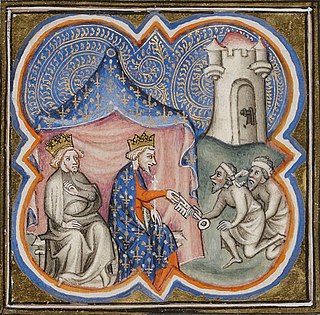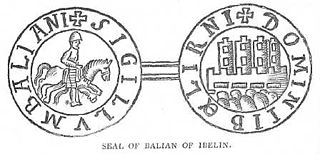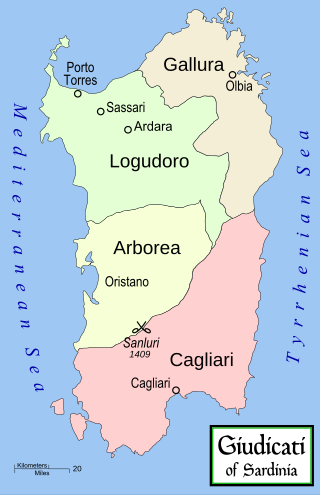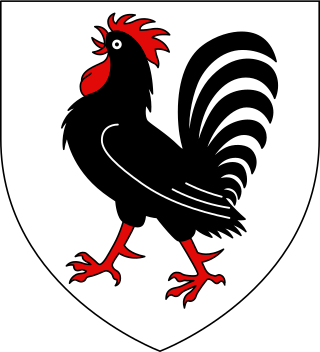Related Research Articles

Year 1135 (MCXXXV) was a common year starting on Tuesday of the Julian calendar.

Year 1190 (MCXC) was a common year starting on Monday of the Julian calendar.

The Fourth Crusade (1202–1204) was a Latin Christian armed expedition called by Pope Innocent III. The stated intent of the expedition was to recapture the Muslim-controlled city of Jerusalem, by first defeating the powerful Egyptian Ayyubid Sultanate. However, a sequence of economic and political events culminated in the Crusader army's 1202 siege of Zara and the 1204 sack of Constantinople, rather than the conquest of Egypt as originally planned. This led to the Partitio terrarum imperii Romaniae or the partition of the Byzantine Empire by the Crusaders and their Venetian allies leading to a period known as Frankokratia, or "Rule of the Franks" in Greek.

Conrad of Montferrat was a nobleman, one of the major participants in the Third Crusade. He was the de facto King of Jerusalem by virtue of his marriage to Isabella I of Jerusalem from 24 November 1190, but officially elected only in 1192, days before his death. He was also the eighth Marquess of Montferrat from 1191.
Boniface I, usually known as Boniface of Montferrat, was the ninth Marquis of Montferrat, a leader of the Fourth Crusade (1201–04) and the king of Thessalonica.

Dagobert was the first Archbishop of Pisa and the second Latin Patriarch of Jerusalem after the city was captured in the First Crusade.

The siege of Acre was the first significant counterattack by Guy of Jerusalem against Saladin, leader of the Muslims in Syria and Egypt. This pivotal siege formed part of what later became known as the Third Crusade. The siege lasted from August 1189 until July 1191, in which time the city's coastal position meant the attacking Latin force were unable to fully invest the city and Saladin was unable to fully relieve it with both sides receiving supplies and resources by sea. Finally, it was a key victory for the Crusaders and a serious setback for Saladin's ambition to destroy the Crusader states.

Isabella I was reigning Queen of Jerusalem from 1190 to her death in 1205. She was the daughter of Amalric I of Jerusalem and his second wife Maria Comnena, a Byzantine princess. Her half-brother, Baldwin IV of Jerusalem, engaged her to Humphrey IV of Toron. Her mother's second husband, Balian of Ibelin, and his stepfather, Raynald of Châtillon, were influential members of the two baronial parties. The marriage of Isabella and Humphrey was celebrated in Kerak Castle in autumn 1183. Saladin, the Ayyubid sultan of Egypt and Syria, laid siege to the fortress during the wedding, but Baldwin IV forced him to lift the siege.

The Piazza dei Miracoli, formally known as Piazza del Duomo, is a walled 8.87-hectare (21.9-acre) compound in central Pisa, Tuscany, Italy, recognized as an important center of European medieval art and one of the finest architectural complexes in the world. It was all owned by the Catholic Church and is dominated by four great religious edifices: Pisa Cathedral, the Pisa Baptistery, the Leaning Tower of Pisa, and the Camposanto Monumentale. Partly paved and partly grassed, the Piazza dei Miracoli is also the site of the Ospedale Nuovo di Santo Spirito, which now houses the Sinopias Museum and the Cathedral Museum.

Balian of Ibelin, also known as Barisan the Younger, was a crusader noble of the Kingdom of Jerusalem in the 12th century. He was lord of Ibelin from 1170 to 1193. As the leader of the defense of the city during the siege of Jerusalem in 1187, he surrendered Jerusalem to Saladin on 2 October 1187.

The Republic of Pisa was an independent state existing from the 11th to the 15th century and centered on the Tuscan city of Pisa. It rose to become an economic powerhouse, a commercial center whose merchants dominated Mediterranean and Italian trade for a century, before being surpassed and superseded by the Republic of Genoa.

William I, royal name Salusio IV, was the judike of Cagliari, meaning "King", from 1188 to his death. His descendants and those of his immediate competitors intermarried to form the backbone of the Italian Aristocracy, and ultimately their descendants in the Medici clan are precursors to, and definers of later royalty and claims thereto.

The Judicate of Gallura was one of four Sardinian judicates in the Middle Ages. These were independent states whose rulers bore the title iudex, judge. Gallura, a name which comes from gallus, meaning rooster (cock), was subdivided into ten curatoriae governed by curatores under the judge. In the 13th century, the arms of Gallura contained a rooster.
Adelasia (1207–1259), was the Judge of Logudoro from 1236 and the titular Judge of Gallura from 1238.

Peter of Capua was an Italian scholastic theologian and prelate. He served as cardinal-deacon of Santa Maria in Via Lata from 1193 until 1201 and cardinal-priest of San Marcello al Corso from 1201 until his death. He often worked as a papal legate. He wrote several theological works and was a patron of his hometown of Amalfi.
The Crusade of 1197, also known as the Crusade of Henry VI or the German Crusade, was a crusade launched by the Hohenstaufen emperor Henry VI in response to the aborted attempt of his father, Emperor Frederick I, during the Third Crusade in 1189–90. Thus the military campaign is also known as the "Emperor's Crusade".

The Campo Santo, also known as Camposanto Monumentale or Camposanto Vecchio, is a historical edifice at the northern edge of the Cathedral Square in Pisa, Italy.

The Visconti of Pisa and Sardinia were an Italian noble dynasty of the Middle Ages. They achieved prominence first in Pisa, then in Sardinia, where they became rulers of Gallura.

The timeline of the Kingdom of Jerusalem presents important events in the history of the Kingdom of Jerusalem—a Crusader state in modern day Israel and Jordan—in chronological order. The kingdom was established after the First Crusade in 1099. Its first ruler Godfrey of Bouillon did not take the title of king and swore fealty to the Latin Patriarch of Jerusalem, Daimbert. Godfrey's brother and successor Baldwin I was crowned the first king of Jerusalem without doing homage to the patriarch in 1100. By 1153, Baldwin I and his successors captured all towns on the Palestinian coast with the support of Pisan, Genoese and Venetian fleets and also took control of the caravan routes between Egypt and Syria. The kings regularly administered other crusader states—the Counties of Edessa and Tripoli and the Principality of Antioch—on behalf of their absent or underage rulers.
Martin was the abbot of the Cistercian monastery of Pairis in Alsace, then part of the German kingdom in the Holy Roman Empire. Martin played a supporting role on the Fourth Crusade. He was a major source for the Historia Constantinopolitana, a history of the Fourth Crusade written by the monk Gunther of Pairis. Gunther's Historia serves as both a eulogy on the life of Martin and also an account of the translation of relics Martin brought to Pairis from the crusade. Gunther describes Martin as pleasant-looking, affable, eloquent, humble and wise.
References
- ↑ Queller & Madden 1997, p. 233.
- ↑ McDougall 2017, p. 241.
- ↑ Bodner 2015, p. 78,79.